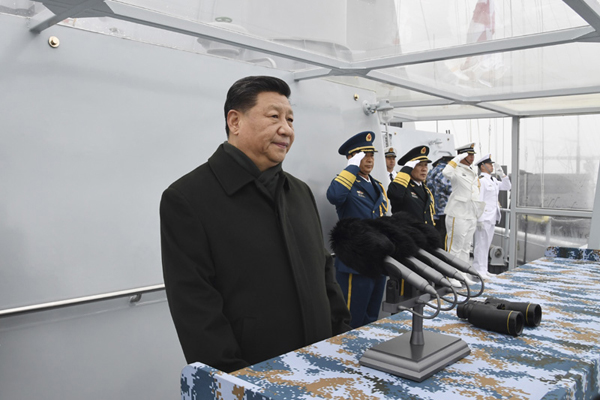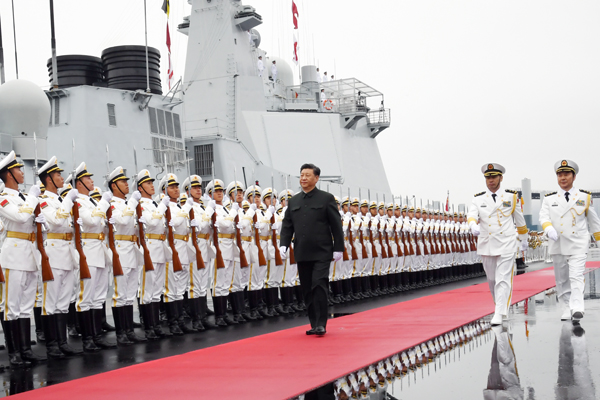
President Xi Jinping, also general secretary of the Communist Party of China Central Committee and chairman of the Central Military Commission, reviews a multinational fleet during a naval parade held in Qingdao, East China’s Shandong province, on April 23, 2019. A naval parade was staged here to mark the 70th founding anniversary of the Chinese People’s Liberation Army Navy on April 23. [Photo/Xinhua]
QINGDAO — Dozens of military vessels flying different national flags lined up in waters off East China’s port city of Qingdao as fighter jets streaked across the sky in formations.
President Xi Jinping reviewed a multinational fleet in the Yellow Sea on the afternoon of April 23 as part of the activities to mark the 70th founding anniversary of the People’s Liberation Army (PLA) Navy.
At around 12:40 pm Xi inspected the honor guards at a pier in Qingdao before he boarded destroyer Xining, which set sail to where the review was to be conducted.

President and Central Military Commission Chairman Xi Jinping inspects the honor guards of the Chinese People’s Liberation Army (PLA) Navy before boarding the destroyer Xining at a pier in Qingdao, East China’s Shandong province, on April 23, 2019. Xi, also general secretary of the Communist Party of China Central Committee, is in Qingdao to review a naval parade staged to mark the 70th founding anniversary of the PLA Navy. [Photo/Xinhua]
At around 2:30 pm Xi, also general secretary of the Communist Party of China Central Committee and chairman of the Central Military Commission, gave the commencing order.
The first stage of the parade featured 32 Chinese navy vessels and 39 aircraft, including China’s first aircraft carrier Liaoning and nuclear-powered submarines.
The vessels sailed in six groups, including submarines, destroyers, frigates, and aircraft carrier, while the aircraft flew in 10 echelons, showcasing warplanes for early warning, reconnaissance, anti-submarine patrol, as well as bombers, carrier-based fighters and helicopters.
Soldiers saluted Xi as their fleets passed by.
“Salute to you, comrades,” Xi called out to the soldiers.
The second stage saw the participation of 18 visiting naval ships from 13 countries, including Russian Navy frigate Admiral Gorshkov and Australian Navy HMAS frigate Melbourne.
The foreign vessels saluted Xi in their traditional manners as they passed by.
Prior to the parade, Xi, in the morning, proposed building a maritime community with a shared future.
In a group meeting with heads of the foreign delegations to the multinational naval events, Xi called for joint efforts to address common threats and challenges at sea.
“The blue planet humans inhabit is not divided into islands by the oceans, but is connected by the oceans to form a community with a shared future, where people of all countries share weal and woe,” he said.
Commander-in-Chief of the Royal Thai Navy Admiral Luechai Ruddit expressed belief that the concept and proposal of a maritime community with a shared future will promote cooperation among navies and contribute to maritime peace and prosperity.
On April 23, 1949, the PLA Navy was founded in a nation which suffered some 470 invasions by foreign powers from the sea between 1840 and 1949.
Seven decades later, it has grown from weak to strong, from coastal waters toward deep blue, evolving into China’s “Great Wall” at sea consisting of five services and with both nuclear and conventional weapons.
With its growth, the PLA Navy has provided the world with more public goods for maritime security.
Since 2008, the navy has sent 32 fleets and more than 27,000 officers and soldiers to escort over 6,600 vessels, more than half of which were foreign ships.
After civil war broke out in Yemen in the spring of 2015, a Chinese naval fleet managed to evacuate 621 Chinese citizens as well as 276 people of 15 other countries out of the war-torn country.
